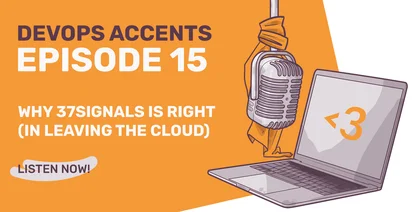Why 37signals Is Right (In Leaving the Cloud) |🎙️#15

In this episode of DevOps Accents, Pablo, Leo and Kirill discuss how and why 37signals, the company behind Basecamp and Hey, successfully left the cloud.
- Majestic Monolith;
- Spend less money and increase performance: what more do you need?
- How to make people believe in your unpoplular idea?
- The Boss vs. the Owner: who makes the tech decision?
- Focus on what you want to achieve, not on the technology to use;
- You might not need to know how to run a cable...
- But you might need to know the basics of networking;
- How did scaling change with Cloud?
- Can the same person maintain cloud infrastructure and on prem infrastructure?
You can listen to episode 15 of DevOps Accents on Spotify, or right now:
In a fascinating turn of events, 37Signals, a company renowned for its innovative approach to software development and its flagship product Basecamp, made a bold decision to migrate from cloud infrastructure back to an on-premise setup. This strategic move has sparked discussions across the tech community, shedding light on the complexities and considerations involved in such a significant transition. This episode delves into the nuances of 37Signals' journey, exploring the technical, financial, and operational aspects that influenced their decision.
The Financial Impetus
The initial revelation that 37Signals managed to save a staggering $1.5 million by moving away from cloud services to an on-premise solution has been a major point of discussion. This decision wasn't made lightly, as it involved meticulous calculations beyond mere infrastructure costs. The company considered various expenses, including electricity, taxes, maintenance, and heat management, ensuring a comprehensive analysis of potential savings. Their successful migration within a mere six months from the announcement further underscores the efficiency and determination behind this endeavor.
Cloud infrastructure costs can quickly spiral out of control, leaving you with unexpected expenses. That’s why we’re offering a Free Cloud Cost Audit — to help companies uncover hidden inefficiencies and optimize their cloud spending. Our goal is simple: empower you with actionable insights so you can take control of your cloud budget.
Learn more about the audit and how we can help here, or fill in the application for right away:
Technical Mastery and Innovation
A key aspect of 37Signals' successful migration was their technical agility and willingness to innovate. By developing their own container runtime, MERS, they demonstrated a commitment to optimizing performance and cost. This move, coupled with their advocacy for a 'majestic monolith' approach to application architecture, allowed for a smoother transition and significant improvements in operational efficiency. This strategic choice highlights the importance of understanding the underlying technologies and being willing to adopt or develop solutions that best fit the company's needs.
Operational Considerations and Team Dynamics
The transition from cloud to on-premise is not merely a technical challenge; it also involves considerable operational changes. 37Signals' approach to managing these changes was methodical and involved leveraging existing expertise within the company. Having maintained an on-premise infrastructure before moving to the cloud, the team possessed the necessary skills and knowledge to navigate this transition effectively. This scenario underscores the value of having a versatile and experienced team capable of adapting to shifting technological landscapes.
Broader Implications for the Tech Industry
37Signals' decision and its subsequent success have sparked a broader conversation about the viability of cloud services versus on-premise solutions. While cloud computing offers scalability and convenience, it comes with its own set of challenges and costs. The company's move challenges the prevailing trend of cloud adoption, suggesting that in certain contexts, on-premise solutions can offer greater control, cost efficiency, and performance benefits.
This case also highlights the importance of a holistic approach to infrastructure management. Understanding the full spectrum of technological, financial, and operational factors is crucial for companies considering similar transitions. It's a reminder that in the rapidly evolving tech landscape, flexibility, and a willingness to challenge conventional wisdom can lead to significant competitive advantages.
Conclusion
37Signals' journey from cloud to on-premise is a compelling case study in strategic decision-making, technical innovation, and operational excellence. It serves as a valuable lesson for other companies navigating the complex terrain of infrastructure management. By critically assessing their needs, exploring innovative solutions, and leveraging their team's expertise, businesses can make informed decisions that align with their long-term objectives and financial goals. As the tech community continues to debate the merits of cloud versus on-premise solutions, 37signals stands as a testament to the benefits of challenging the status quo and charting one's path based on thorough analysis and strategic vision.
Podcast editing: Mila Jones, milajonesproduction@gmail.com
